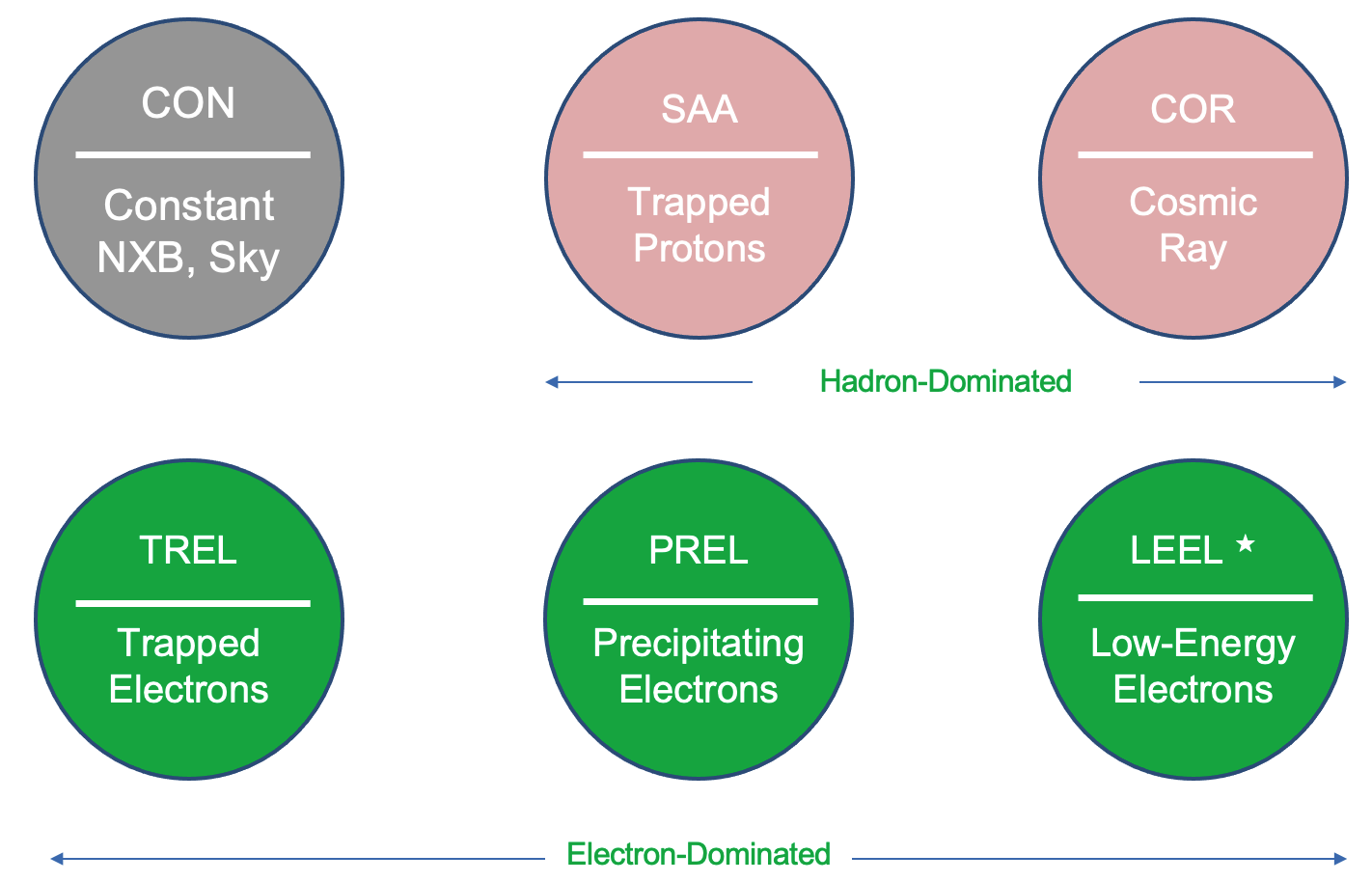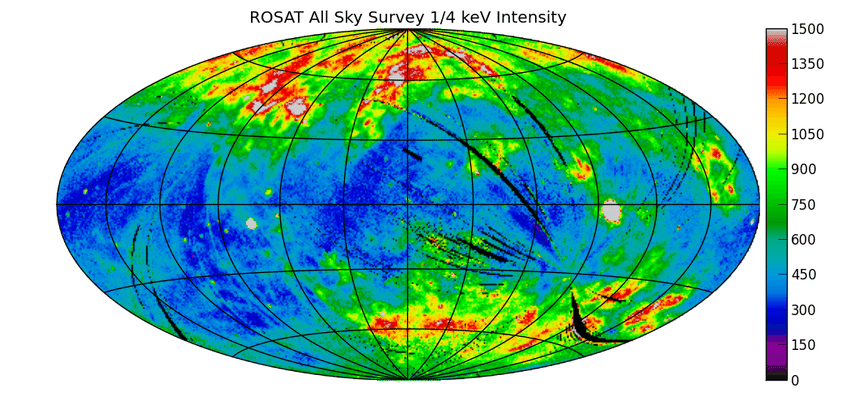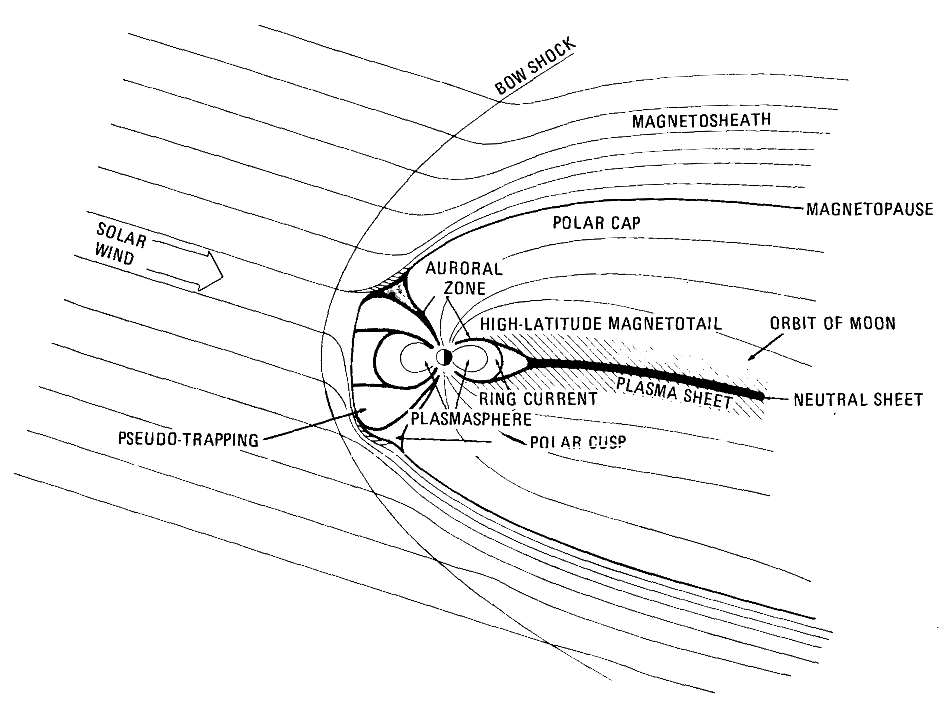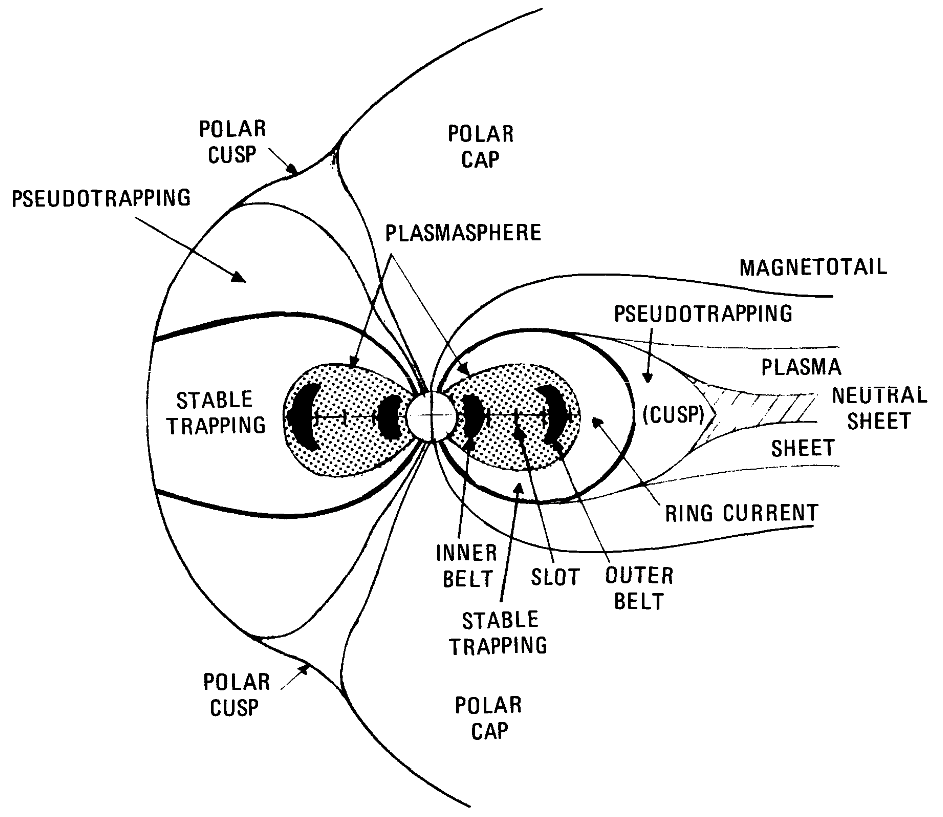SCORPEON Background Model OverviewReturn to: Analysis Threads | Analysis Main Page
Overview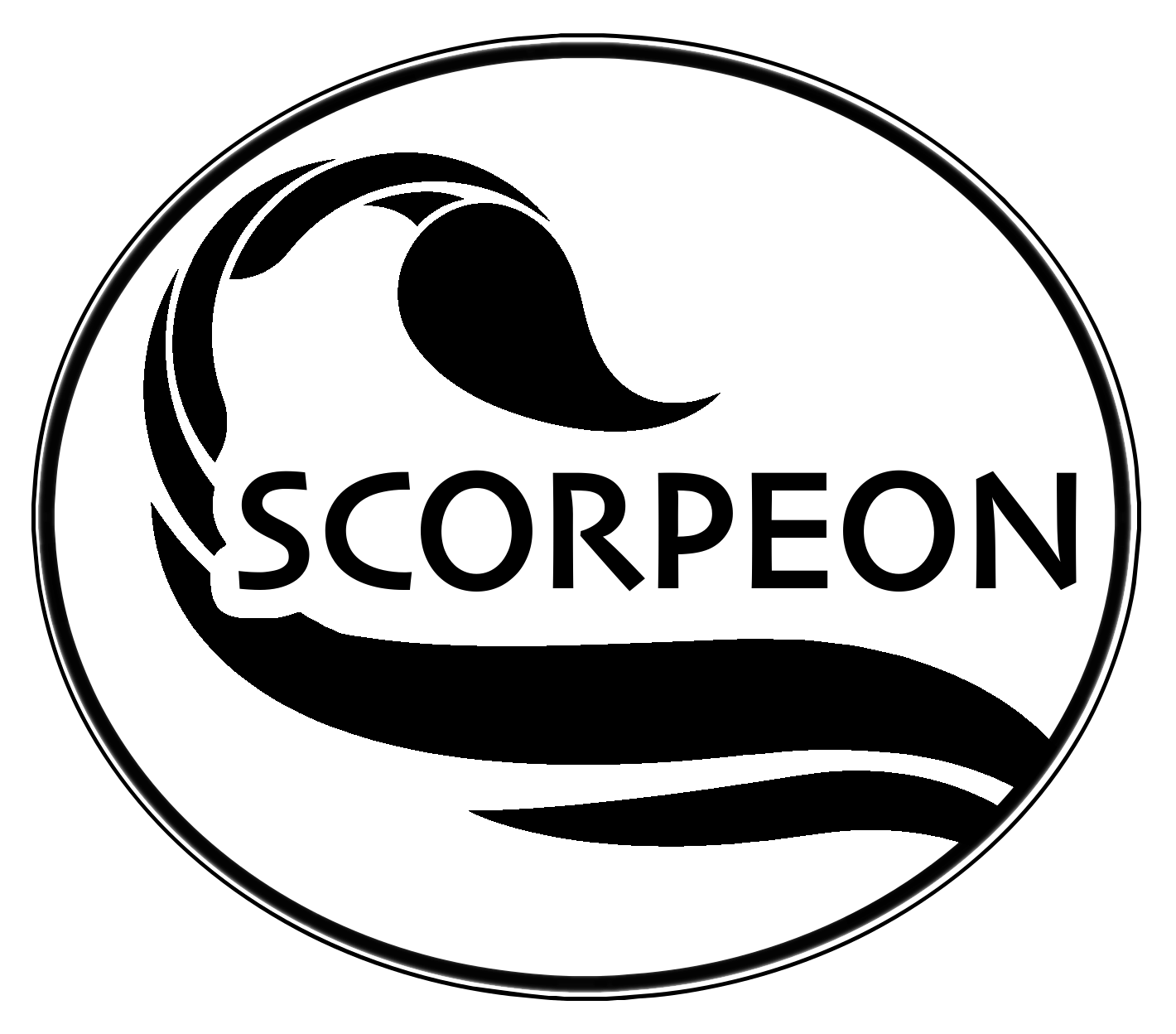
Since NICER is a non-imaging detector we must estimate background using a model. This thread provides an overview of the SCORPEON background model, which is different than other background modeling approaches. Read this thread if you want to: Understand the basics of SCORPEON Last update: 2024-07-19 IntroductionHere, "background" can be defined broadly to include anything that contributes non-source counts to NICER counts during an observation. These can include:
In general, the non X-ray background components vary as a function of time, so they must be somehow parameterized. In addition, the X-ray backgrounds can vary as a function of location on the sky, both due to cosmic variance, as well as variations of foreground X-ray emission as a function of galactic coordinates. All NICER background models are created by examining dedicated background observations by NICER of "blank sky" regions. In the case of NICER, the blank sky regions are borrowed from RXTE's background fields (although it should be noted that the fields of view for RXTE and NICER are dramatically different). The background model is fitted or trained in some way on this data, using several parameters. How the background model is trained makes it unique, and different models are parameterized differently. Once the background model has been trained, it can be applied to other observations using the same parameters the model has been trained on. For example, for a model trained on COR_SAX and NICER Overshoots, the background estimation tool would retrieve the COR_SAX and overshoot values for the observation in question, and use those as parameters to the background model to estimate a background tailored to the specific observation. The SCORPEON model described here is indeed trained primarily upon NICER overshoots and COR_SAX. Additional sky background terms are estimated from published work. This document provides an overview of the SCORPEON background model. Additional documentation regarding how to use SCORPEON, guidance, tips and tricks, will be forthcoming. Comparison of NICER Background ModelsAs of this writing, the NICER team provides three background models as a part of the NICER standard software, the SCORPEON model, the 3C50 model, and the Space Weather model. How do these compare?
It's apparent that the three background models are actually quite different. They are trained on different quantities, have different capabilities, and have different development philosophies. One of these philosophies, the difference between a "library" and "parameterized" model, will be discussed next. We will highlight a few other differences here. The SCORPEON model produces a background model that can be fitted along with your source model. This capability has a number of benefits. Primarily, you are likely to get a much better match of the background to your observational data. After fitting, and assuming you have a good source model, you should not have background over- or under-subtraction problems. Also, by fitting background as well as source, you will more accurately reflect the covariance of background uncertainties with your source spectrum uncertainties. In other words, you are likely to get a more realistic estimate of your source parameter uncertainties by allowing the background parameters to vary. Please note that the optional separate tool niscorpspect can also produce a static SCORPEON background file that can be used during spectral fitting or for exporting to non-XSPEC software, but it will not have the benefits describe above. SCORPEON explicitly handles astrophysical X-ray sky backgrounds. These include the Cosmic X-ray Background (CXB), Local Hot Bubble (LHB) and galactic X-ray Halo ("Halo"). These terms are derived from published sources and a priori estimates for the norms are provided by SCORPEON. In addition, terms for solar wind charge exchange and neutral oxygen are included in SCORPEON, although they default to "off." SCORPEON always produces an estimate. The 3C50 model may discard data when no matching library cell can be found. The SCORPEON model will always produce an estimate for your existing spectrum. The SCORPEON background model components are smooth curves. Unlike library models such as 3C50 and Space Weather, which have Poisson variations built in to their library spectra, the SCORPEON templates are smoothed. You can be sure that background model estimates are not the source of fluctuations you see in your spectra. The NICER noise peak is included. A model component is included for the noise peak, and the shape and normalization of the peak are estimated a priori. This allows spectral fitting to extend down to 0.22 keV.
Which background model should you use? The spectral analysis
tool nicerl3-spect makes it easy to try different background models,
so you can try them all and see which works best for your application.
Here are some guidelines to get you started.
Developmental PhilosophyThe SCORPEON background model was developed during 2022 in order to fill perceived needs for the NICER background community. First of all, SCORPEON should be physically-motivated to the greatest degree possible. This means looking to known physical phenomenon (such as precipitating electrons) as the model was constructed. Doing so lends credibility to the underlying understanding of the functioning of the model. However, it should be understood that one cannot always perfectly associate a measured behavior with a known physical phenonemon so we should not think SCORPEON is a perfect physical description of NICER's background. Furthermore, when needed, we have resorted to phenomenological associations. Second, SCORPEON should provide smooth template spectra that continuously vary with its parameters. As a parameterized model (rather than a library model), it should be able to respond to all conditions, even extrapolating outside of the parameter ranges it was trained on. This provides a background estimate for all data sets, and no "quantization steps" as might be seen when using a library-type model. However, extrapolated background estimates may be a lower quality. The ability to have a fittable background model within XSPEC came later, after it became clear that there were more components than could be determined by overshoots and COR_SAX. What's in the SCORPEON Name?The SCORPEON name is an acronym that describes the components that are included in the model. Here is a summary of the acronym letter meanings.
The SCORPEON name was attached early in the project, before it was understood how many actual components would be needed to accurately describe NICER's background. At this point, some letters in the acronym do double- (or multiple-) duty. Thus, it may be best to think of SCORPEON simply as a name rather than as an explicit acronym. SCORPEON Background ComponentsLet's discuss in more detail what model components are included within SCORPEON. Next to each of the components you will see a three- or four-letter code, which is how this component is commonly referred to during analysis.
The following diagram provides an overview of the background components
included within SCORPEON: X-ray Sky BackgroundsX-ray sky backgrounds are due to X-rays that pass through the optics just like X-rays from the target. These undesireable X-rays are indistinguishable, other than by spectrum, from the desirable X-rays from the target. Furthermore, some components vary with look direction. Therefore, they can only be accounted for properly by modeling, using the known properties of these backgrounds.
Cosmic X-ray Background (CXB). The cosmic X-ray background is
the well-known flux of X-rays from cosmic distances, primarily from
distant active galaxies. The normalization (cxb_norm) and spectral
shape are taken from Cappelluti et al. (2017; ApJ 837 19). Although
the CXB is constant in time, it does vary from point to point on the
sky (i.e. cosmic variance), and for NICER's aperture size the
variation can be 20% (1 sigma; see Moretti et al. 2009, A&A 493
501). The norm is in units of
photons s-1 cm-2 sr-1.
Solar Wind Charge Exchange (SWCX) and Neutral Oxygen (OK). Solar wind charge exchange (SWCX) is a charge exchange interaction between the solar wind ions and atmospheric atoms within the geomagnetosphere. High speed ions can capture an electron from neutral atoms near the earth, and the resulting cascade to the ion's ground state results in X-ray emission. NICER has seen significant Kα emission from O VII (574 eV), O VIII (654 eV), and Ne IX (898 eV). This emission can vary on timescales of minutes and varies with look direction as well. The intensity is not predictable in a straightforward operational way. Oxygen K emission from neutral atoms has also been seen in NICER observations (Kα emission line at 533 eV). This phenomenon is an area of research, but the proposed mechanism is that solar X-rays ionize neutral oxygen that upwells into the polar cusp regions. In practice, while there is a rough correlation with the cusp regions, we have often seen emission from a much broader region, and sometimes not at all. Again, the intensity is not predictable in a straightforward way. Because of the behavior of both SWCX and neutral oxygen, these lines are included in the model but the norms default to zero. It is up to the user to recognize these lines and allow the norms to vary. The norms (ok_norm, ovii_norm, oviii_norm, neix_norm) are in units of photons s-1 cm-2 sr-1. Non-X-ray BackgroundsNon-X-ray background components originate due to particle interactions or noise events within the NICER detectors. All of these components require a separate non-X-ray diagonal response matrix, which is provided by the standard processing tools. Where possible, components are normalized in terms of detector overshoots, so that a norm of 1.0 indicates the spectrum from that component when the overshoot rate is 1.0 counts per second in the NICER array (i.e. not counts per detector). Non-X-ray backgrounds depend on conditions within the geomagnetosphere, which is formed by a complex interaction between the solar wind and magnetic field, and the earth's magnetic field. As shown in the image below (Noll & McElroy 1975), this arrangement of magnetic fields produces distinct regions where high energy particles can be channeled, scattered, trapped and shielded.
NICER resides in a low earth orbit which is partially shielded from many charge particles, but some particle populations either can penetrate through the geomagnetosphere, or become trapped inside. The close-up view below (also due to Noll & McElroy) shows a better schematic view of the relevant regions.
Particles with high enough energy (~tens of MeV) can penetrate NICER mechanical structures and deposit charge within NICER detectors. Lower energy charged particles can enter the NICER aperture and be scattered / concentrated into the NICER detectors. NICER can to some extent resolve the difference between high energy particles and X-rays, but low energy electrons are a different matter. Constant Non-X-ray Background (CON). The constant non-X-ray background is the background that does not appear to vary with time (or more specifically, with overshoots) and is not associated with an X-ray background. Since it is not modulated by magnetic field, it is probably associated with cosmic gamma-rays and its associated atmospheric albedo reflection. High energy gamma-rays from outside the solar system can either interact directly in NICER's detectors and deposit charge, or interact in the earth's atmosphere causing upward-going charged particles to hit NICER. This background component is applied to every spectrum and is normalized by number of enabled detectors. Cosmic Rays (COR). High energy cosmic rays permeate the galaxy. As is well known, cosmic rays can be detected with energies that extend up to ~1020 eV. However, these extremely high energy cosmic rays are rare. In practice, it is the plentiful ~GeV cosmic rays that dominate NICER's background due to this source. All cosmic rays above ~50 MeV have enough energy to deposit minimum ionizing radiation (~200 keV) in NICER's detectors as they pass through. Most of these events produce overshoots (>20 keV), but some trajectories deposit less charge, which are registered as X-ray-like background. Although the earth and sun do provide magnetic shielding from cosmic rays, cosmic rays are able to pentrate through the cusp regions, and anywhere where the magnetic field strength (cut-off rigidity) is low enough. Thus, the cosmic ray background is cut-off rigidity dependent, with the lowest background at the magnetic equator and highest in the polar horn regions. The cosmic ray background is very predictable. It is stable on day to month time scales, with small variations due to solar magnetic potential variation, which is accounted for in SCORPEON using the SOLAR_PHI parameter. The cosmic-ray norm (cor_norm) is expressed in units of overshoot-equivalent counts, as computed from the COR_SAX and SOLAR_PHI parameters. Trapped Electrons (TREL). Although many charged particles enter and then leave the geomagnetosphere, some become trapped. Trapping timescales are stable on the time scale of a ~day. The outer belt is dominated by trapped electrons, which appear in NICER's orbit primarily at high north and south latitudes near the polar horn regions. Trapped electrons have energies predominately below 1 MeV. Trapping can be enhanced or depleted, depending on the alignment between the geomagnetic field and the the interplanetary (solar wind) magnetic field, and thus is highly variable on time scales of ~days. This component is not predictable and must be estimated based upon overshoots. The trapped electron norm (trel_norm) is expressed in units of overshoots. Precipitating Electrons (PREL). The plasma sheet region of the magnetosphere is a region where magnetic reconnection events can occur. These events can energize a population of copious >keV electrons that in turn travels along field lines to the earth where they are often absorbed by the atmosphere in the auroral (polar horn) regions. However, NICER is also sensitive to such electrons, which can enter the apertures and scatter to NICER detectors where they are directly absorbed in the Silicon active layer. As a direct soft electron component, few overshoots or trumpet-rejected counts are produced. These events are detected by NICER almost exclusively at high magnetic latitudes (COR_SAX < 1.5), and the NICER spectrum is quite flat sometimes with a turn-over above ~10 keV. They can be extremely intense (>50,000 ct/s) on timescales of seconds, but less intense and slower-evolving on other occasions. Such events are extremely unpredictable and because they produce few overshoots, it is difficult to distinguish them from less intense trapped electron events. Thus, the precipitating electron normalization (prel_norm) is set to zero by default, but allowed to vary if COR_SAX < 1.5 at any point in the observation. Low-Energy Electrons (LEEL). Low-energy electron events are characterized by a flat spectrum up to ~2 keV and a rapid fall-off above that energy (hence the phenomenological name). They can appear anywhere in NICER's orbit, especially in typically quiescent portions of the orbit where cosmic rays usually dominate. The origin of this population of events is uncertain, but appears to be related to strong solar storm events that inject enough charge into the magnetosphere that some of it can diffuse into the inner radiation belt. Just as for trapped and precipitating electrons, the low-energy component is highly unpredictable, although there is some correlation with recent storms, as indicated by the Dst storm index. The low-energy electron norm (leel_norm) is set to zero by default, but allowed to vary over a wide range. Detector "Background" FeaturesNICER's FPM detectors can also produce detector features that are not related to the X-ray sky or the particle environment, but still appear as counts in an X-ray spectrum. Here we discuss the one feature that is included in SCORPEON, the noise peak. Noise Peak. NICER detectors have a measurement processing system which allows some noise events to pass through the system. A unique feature of this system is that the noise peak appears below the low energy threshold, typically at a centroid energy of ~120 eV and 1 sigma width of ~25 eV. The parameters of this noise peak vary with optical loading (undershoots) in a very predictable manner. SCORPEON models the noise peak as a single gaussian with centroid energy (noise_ecent), 1-sigma width (noise_ewid), and normalization (noise_norm) in units of counts/s. These parameters are predicted a priori, but in many cases (see below) extra counts can appear in the noise peak area in the 0.2-0.5 keV range. Noise Peak Tail. The NICER team has become aware of a new phenomenon related to the noise peak that appears under high optical loading (undershoot) conditions. In these situations an extended tail of the noise peak, which the team is calling "a noise ringer tail," can appear in the 0.2-0.5 keV range. Currently this effect is unmodeled but under investigation. How to Use SCORPEONSCORPEON is delivered as a part of NICERDAS (version 10+, HEASoft 6.31 or higher). Users with updated software and calibration should be able to use any of the NICER background models without separate downloads. Please see the Using SCORPEON Models analysis thread, which provides a detailed example of generating a SCORPEON background model and using it within XSPEC. As a summary, users will run nicerl2 to generated a calibrated and screened data set, and nicerl3-spect to generate spectral products including responses and backgrounds. Then they will load these products into XSPEC for further analysis. nicerl3-spect is a complete spectral products pipeline. This is the recommended way to make all spectral products, including spectrum, responses, and background estimates. The user can control various aspects of the product generation, including which background model to apply. Because this pipeline generates all of its products in a consistent way according to the NICER team recommendations, this is the best way to obtain reliable spectral results. It is especially useful for NICER astronomers just starting, but also powerful enough to be used by advanced users. Please see the nicerl3-spect Thread for more detailed information. Running SCORPEON manually is possible but not recommended. Users are likely to get a better experience using nicerl3-spect. However scientists with legacy workflows may need to run the SCORPEON tools directly. Please see the Manually Estimating NICER Backgrounds Thread for more information. After generating a background, the scientist still needs to use this estimate within the spectral analysis package XSPEC. A detailed tutorial on this subject is provided on the Using SCORPEON Models analysis thread. Supported SoftwareCurrently NICER SCORPEON supports HEASoft spectral fitting packages, namely XSPEC. Other packages such as CIAO or SPEX are not directly supported. In the future SCORPEON may move to a system where SCORPEON templates are defined as local models rather than "mdefine" statements, which may improve compatibility with other packages. Modifications
|


